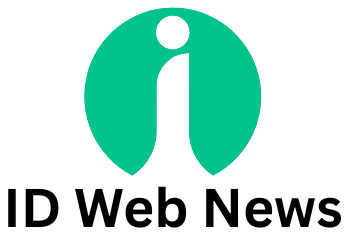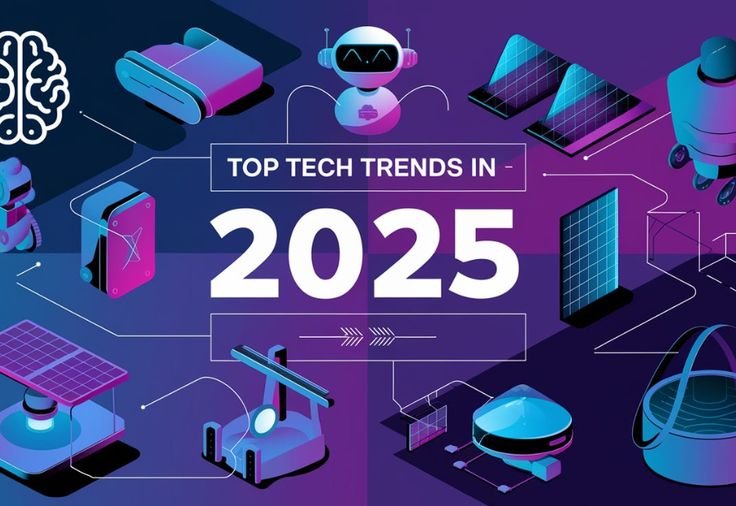The technology landscape in 2025 is a testament to human ingenuity, reshaping industries, daily life, and how we interact with the world. Driven by advancements in artificial intelligence, sustainability, and connectivity, this year’s breakthroughs are creating ripples across businesses, healthcare, education, and personal convenience. These innovations not only simplify processes but also address global challenges, paving the way for a smarter and more sustainable future.
This article explores the top tech trends of 2025, highlighting their applications, advantages, and the far-reaching impact they hold for businesses and consumers.
1. Hyperautomation Driving Workflow Efficiency
Hyperautomation has matured, emerging as a central tech trend in 2025. By combining AI, machine learning, and robotic process automation (RPA), hyperautomation eliminates repetitive tasks, enabling businesses to optimize workflows at scale.
Applications:
- Healthcare: Automated patient check-ins, predictive analysis for disease management, and resource scheduling in medical facilities.
- Finance: Robotic processing for document verification, fraud detection, and portfolio management.
- Manufacturing: Smart factories adopting automated inventory management systems powered by IoT (Internet of Things).
Benefits:
- Amplifies employee productivity by automating mundane tasks.
- Reduces operational costs.
- Improves precision, minimizing errors in data-dependent industries.
Recent studies estimate that hyperautomation will result in a 27% productivity boost for industries that adopt it by the end of the year.
2. 6G Connectivity Taking Devices to the Next Level
The rollout of 6G networks has begun transforming connectivity standards. With speeds up to 100 times faster than 5G, 6G expands the possibilities for data transmission, making real-time, high-quality communication an everyday reality.
Key Applications:
- Immersive Telepresence: From virtual meetings that feel physical to holographic communications for cross-border collaborations.
- Healthcare: Enabling remote robotic surgeries with minimal latency.
- Autonomous Vehicles: Faster data exchange between vehicles and infrastructure for safer urban mobility.
Consumer Impact:
For everyday users, 6G translates into instantaneous downloads, lag-free cloud access, and new interactive experiences in gaming, entertainment, and education.
3. Ethical AI and Explainable Machine Learning
AI adoption has long been criticized for opacity, with decisions often incomprehensible to end-users. Ethical AI initiatives in 2025 seek to address these concerns through transparency and fairness.
Features of Ethical AI:
- Explainable Decision-Making: Algorithms that justify and clarify outcomes, such as loan approvals or medical diagnoses.
- Bias Mitigation: Enhanced techniques to eliminate data prejudice in systems, fostering inclusivity.
- Regulation Alignment: AI designs adhering to both global guidelines and local policies.
Business Example:
Major corporations like Microsoft have deployed Explainable AI models, allowing businesses and customers alike to trust machine-learning outcomes across hiring, marketing, and profiling scenarios.
For industries, building trust with transparent AI not only improves compliance but also strengthens customer loyalty.
4. Green Tech and Sustainable Innovation
Sustainability continues to dominate tech agendas, with companies turning to green innovations to lead eco-conscious revolutions. Green tech in 2025 is defined by solutions that reduce environmental impact while maintaining efficiency.
Notable Green Tech Advancements:
- Modular Electronics: Devices with interchangeable components to reduce e-waste. For example, smartphones designed for modular upgrades rather than replacements.
- Carbon-Neutral Data Centers: AI-optimized cooling and renewable energy power centers set benchmarks in energy efficiency.
- Solar Innovations: Affordable, high-yield photovoltaic modules enabling device charging using compact solar panels.
Impact on Consumers and Businesses:
Sustainable design is influencing purchasing decisions, with more than 60% of buyers selecting green-certified devices when presented with alternatives.
5. Personalized Healthcare Through AI and Wearables
Healthcare is experiencing a paradigm shift toward personalized medicine. By integrating AI-powered diagnostics with wearable technologies, individuals in 2025 are empowered to proactively monitor and optimize their health.
Leading Innovations:
- AI-Driven Diagnostics: Platforms like HealthMap 360 provide real-time predictive insights into potential ailments based on daily habits and health history.
- Wearables: Devices such as the BioFit Tracker detect stress, hydration, sleep quality, and even early cardiovascular risks.
Benefits for Society:
These tools enable proactive prevention rather than reactive treatments, reducing healthcare costs and improving life expectancy by addressing conditions before they manifest.
6. The Rise of Quantum Computing
Quantum computing, having moved beyond experimental phases, is now reshaping fields that require massive data processing. Offering computational speeds magnitudes faster than traditional systems, it’s revolutionizing areas like finance, logistics, and drug discovery.
Real-World Examples:
- Drug Development: Identifying potential molecules for treatment within hours instead of years.
- Financial Risk Analysis: Real-time, comprehensive forecasting for high-stakes investments.
- Supply Chain Optimization: Helping enterprises streamline logistics even in complex global networks.
Quantum computing’s precision and speed offer solutions that were previously unfeasible, positioning early adopters as industry leaders.
7. Immersive Experiences with Augmented Reality (AR) and Virtual Reality (VR)
Immersive technologies have achieved widespread adoption by making both AR and VR more accessible. From education to retail, these tools enhance interaction, creating lifelike environments for users to explore.
Key Applications:
- Retail: AR allows shoppers to virtually try on clothes or furniture before purchasing.
- Education: VR-based programs are recreating historical events in classrooms, making lessons captivating.
- Gaming and Entertainment: Enhanced sensory feedback redefines how users experience movies and games.
The popularity of AR pairing with wearables is expected to generate $14 billion in revenue by the end of 2025.
8. Decentralized Identity Technologies
As privacy concerns mount, decentralized identification systems are becoming more prominent. These technologies give users greater control over personal data while reducing identity theft risks.
How It Works:
- Users maintain personal data on secure, decentralized platforms.
- Access is granted selectively, ensuring data privacy and user confidentiality.
Governments and enterprises are adopting decentralized IDs for secure online transactions and verified access to services, offering consumers greater peace of mind in a digitally connected world.
9. Robotics Becoming More Humanlike
The introduction of advanced humanoid robots in 2025 has brought automation closer to real-world human experiences. These robots are now capable of interacting empathically, responding naturally, and executing intricate tasks.
Notable Developments:
- Caregiving robots assisting with elder care needs.
- Hospitality robots acting as multilingual assistants at international venues.
- Advanced delivery robots in urban hubs enabling faster e-commerce logistics.
Future iterations aim to strike better balances between robotics efficiency and human interaction parity.
10. Biometric Security Advancements
Passwords have steadily been phased out as biometric tech takes center stage in ensuring personal and enterprise-level security. From fingerprints to eye recognition, these systems provide seamless, highly reliable access control.
Revolutionary Features:
- Multi-layer biometric verification combining facial recognition with voiceprints.
- Contactless scanners ensuring quick validation in public areas like airports.
This makes biometric technologies not just convenient but essential in high-security risk scenarios.
Leveraging Tech Trends for a Smarter Tomorrow
The short-term and long-term applications of 2025’s tech advancements favor not only companies seeking operational excellence but also consumers demanding refined, immersive experiences. Whether adopting sustainable practices, leveraging predictive healthcare, or using decentralized security solutions, these technologies are redefining modern life.
Staying informed about and adopting these trends will enable individuals and businesses to lead in an increasingly competitive, innovative landscape. The future is here—how will you leverage these breakthroughs?

